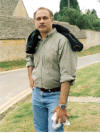|
|
the-south-asian.com July / August 2006 |
|
|||
|
August/September Contents
Sufis
- wisdom against 50
years of mountain Heritage cities:
Cotton - the fibre of
|
|
||||
|
Page
2 of 2
Interview with Dr.Ajaz Anwar –Associate Professor , National College of Arts, Lahore, Pakistan By Salman S. Minhas.
First published in
November 2003 (cntd.)
TSA : Could you also tell us when and how you started painting buildings of old Lahore ? Dr.Ajaz Anwar: There was our teacher Mr. Aslam Minhas in Government College. For one he was related distantly to us. He had started the Fine Arts department. This was in the days of Dr. Nazir who was later the principal there. Government College is still the only college for men to have a Fine Arts department. The rest are all girls’ colleges. He was, without being strict, a disciplinarian. This also is a quality of a teacher. We were only 3 students. He got us a key made so that we could work whenever there was a free period. We would go on Sundays. The guards [ Chowkidars] initially were alerted. Later they learnt that 3 students would be coming on Sundays. In a way that was our "Midway" house and our painting gear would also be left there. On Sundays, we would take our painting tools and go to the Ravi river. He [ Aslam Minhas] was there during college hours. He was very punctual, very regular. At 8:30 a.m. he would leave his bike under the stairs. We would dust it off with a cloth. He was a kind man. In the beginning, he took us to Urdu bazaar. There, we went up the steps of Sadaqat Stationary Mart as he knew those people. He got us three chairs and said these guys will be coming daily. There was this magnificient view from the roof. He said "Everywhere you look there is a picture; you can reject it or you can choose to paint it . But try and make some composition out of it". His lectures too were not speeches but conversations. Years later I realised that a good lecture is one in which there is a dialogue - a two-way conversation. Our conversations ranged from the Indus Valley, a little on Gandhara, then Ajanata , etc . So with this dialogue, we learnt faster, and did not have to study much after that. In the beginning we began painting with watercolours. You have to think right from the beginning. If something goes wrong, you cannot undo it. The white of the paper serves as the white colour.
TSA : Could you also tell us about the situation regarding old buildings in Rawalpindi and Peshawar, Karachi, and also the situation in Lahore with respect to the heritage of old architecture. What new projects are you working on? Dr.Ajaz Anwar: In Lahore, there was a demonstration in 1996 by the NCA students against the demolition of the Tollington market which was joined spontaneously by the citizens of Lahore . As a result the demolition of Tollington market was halted. However the so-called food street renovation of Gowalmandi and Old Anarkali is basically not organic. It is in the hands of the land mafia and Multi-Nationals whose basic motive is the bottom line profits. The reconstruction of Tollington market is not being supervised by an architect or conservation specialist. It is in the hands of a government contractor and you know what that means. I am working on the painting of an old building on Mcleod road/ Nicholson road. The story behind this building is a long one. I managed to get my students to take some pictures of it before it was demolished. For Lahore a 5-storey building is a skyscraper.
Dr.Ajaz Anwar: First of all I teach only art history. I cannot speak about the level of the craft of painting. A good teacher teaches a student to cross the street on his own and not hold his hands every time. Every age has its golden art. Every person belongs to his own age.
|
|||||
|
Copyright © 2000 - 2006 [the-south-asian.com]. Intellectual Property. All rights reserved. |
|||||


